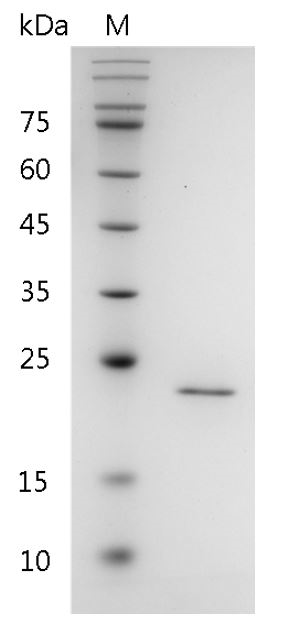| Product name | Human FGF-3 Protein, His tag (Animal-Free) |
| Sequence | Amino acid sequence derived from Human FGF-3 (Asp28-Arg212) (P11487) was expressed with 6×His tag at the C-terminus |
| Applications | His tag |
| Applications notes | Human |
| Activity | Measure by its ability to induce 3T3 cells proliferation.The ED50 for this effect is <78 ng/mL |
| Protein length | The recombinant Human FGF-3 consists of 185 amino acids and predicts a molecular mass of 26.9 kDa |
| Preparation method | E. coli |
| Purity | >95% as determined by SDS-PAGE. |
| Alternative | HBGF-3, INT2 |
| Formulation | Lyophilized from PBS, pH 7.4 |
| Features & Benefits | Endotoxin: <0.1 EU per 1 μg of the protein by the LAL method. |
| Molecular weight | 26.9 kDa |
| Usage notes | Always centrifuge tubes before opening. It is recommended to reconstitute the lyophilized recombinant protein to a concentration of 0.1-1 mg/mL using the buffer we provided, and keep at room temperature for at least 20 min to fully dissolve. Please avoid vortex vigorously |
| Storage instructions | Lyophilized protein product should be stored desiccated below -18°C. Upon reconstitution, the protein should be stored at 4°C between 2-7 days and for future use below -18°C. For long term storage it is recommended to add a carrier protein (5% HSA , 10%FBS or 0.1%BSA). Please prevent freeze-thaw cycles |
| Shipping | Gel pack with blue ice. |
| Precautions | The product listed herein is for research use only and is not intended for use in human or clinical diagnosis. Suggested applications of our products are not recommendations to use our products in violation of any patent or as a license. We cannot be responsible for patent infringements or other violations that may occur with the use of this product. |
| Background | Fibroblast Growth Factor 3 (FGF-3) belongs to the large FGF family which has at least 23 members.FGFs are expressed during embryonic development and in restricted adult tissues. They act on cells of mesodermal and neuroectodermal origin to regulate diverse physiologic functions including angiogenesis, cell growth, pattern formation, embryonic development, metabolic regulation, cell migration, neurotrophic effects and tissue repair . Signaling receptors for FGFs are type I transmembrane receptor tyrosine kinases belonging to the Ig superfamily. Four distinct but related classes of FGF receptors, FGF R1, 2, 3, and 4, exist. Through alternative splicing, multiple isoforms for FGF R1, 2 and 3, with distinct ligand recognition profiles, are also generated |
| Alternative | HBGF-3, INT2 |
| Accession | P11487 |

You must be logged in to post a review.
Reviews
There are no reviews yet.